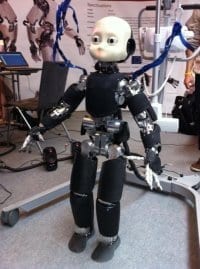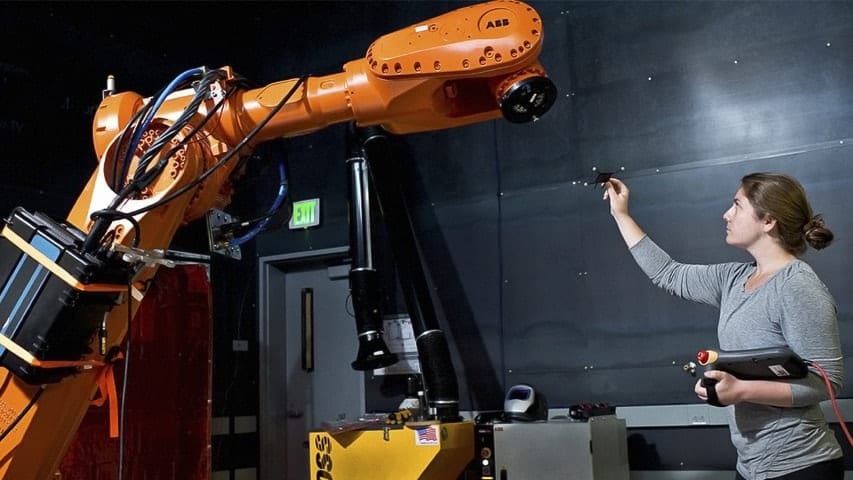
A robot that feels, sees and, in particular, thinks and learns like us.
It still seems like science fiction, but if it’s up to UT researcher Frank van der Velde, it won’t be. In his work he wants to implement the cognitive process of the human brain in robots. The research should lead to the arrival of the latest version of the iCub robot in Twente. This human robot (humanoid) blurs the boundaries between robot and human.
Decades of scientific research into cognitive psychology and the brain have given us knowledge about language, memory, motor skills and perception. We can now use that knowledge in robots, but Frank van der Velde’s research goes even further. “The application of cognition in technical systems should also mean that the robot learns from its experiences and the actions it performs. A simple example: a robot that spills too much when pouring a cup of coffee can then learn how it should be done.”
Possible first iCub in the Netherlands
The arrival of the iCub robot at the University of Twente should signify the next step in this research. Van der Velde submitted an application together with other UT researchers Stefano Stramigioli, Vanessa Evers, Dirk Heylen and Richard van Wezel, all active in the robotics and cognitive research. At the moment, twenty European laboratories have an iCub, which was developed in Italy (thanks to a European FP7 grant for the IIT). The Netherlands is still missing from the list. Moreover, a newer version is currently being developed, with for example haptic sensors. In February it will be announced whether the robotics club will actually bring the latest iCub to the UT. The robot costs a quarter of a million Euros and NWO (Netherlands Organisation for Scientific Research) will reimburse 75% of the costs. Then the TNO (Netherlands Organisation for Applied Scientific Research) and the universities of Groningen, Nijmegen, Delft and Eindhoven can also make use of it. Within the UT, the iCub can be deployed in different laboratories thanks to a special transport system.
Robot guide dog
“The possibilities are endless, realises Van der Velde. “The new iCub has a skin and fingers that have a much better sense of touch and can feel strength. That makes interaction with humans much more natural. We want to ensure that this robot continues to learn and understands how people function. This research ensures, for example, that robots actually gather knowledge by focusing on certain objects or persons. In areas of application like healthcare and nursing, such robots can play an important role. A good example would be that in ten years’ time you see a blind person walking with a robot guide dog.”
Nano-neural circuits
A recent line of research that is in line with this profile is the development of electronic circuits that resemble a web of neurons in the human brain. Contacts have already been made to start this research in Twente. In the iCub robot, this can for example be used for the robot’s visual perception. This requires a lot of relatively simple operations that must all be performed in parallel. This takes a lot of time and energy in the current systems. With electronic circuits in the form of a web of nerve cells this is much easier.
The Latest Bing News on:
Human Robot
- Elon Musk Keeps Talking About the Future of Robotics With Optimus, but This Phenomenal Growth Stock Has Already Been Using Robots in Restaurants for Over a Year.on May 1, 2024 at 4:45 am
Elon Musk Keeps Talking About the Future of Robotics With Optimus, but This Phenomenal Growth Stock Has Already Been Using Robots in Restaurants for Over a Year.
- Cobot proudly reveals innovative non-humanoid robots, announces $100M Series B.on April 30, 2024 at 9:01 am
The burgeoning field of robotics, traditionally dominated by applications in heavy industry and scientific research, is experiencing a significant shift as startups like Sunnyvale, California’s Collaborative Robotics,
The Latest Google Headlines on:
Human Robot
[google_news title=”” keyword=”Human Robot” num_posts=”10″ blurb_length=”0″ show_thumb=”left”]
The Latest Bing News on:
Humanoid robots
- New Clip From ‘Mars Express’ Reveals Terrifying Robot Attackon May 1, 2024 at 4:59 am
Watch an exclusive clip of the upcoming neo-noir sci-fi release "Mars Express" from GKIDS, who brought Oscar-winner "The Boy and the Heron" to domestic theaters last year.
- Elon Musk Keeps Talking About the Future of Robotics With Optimus, but This Phenomenal Growth Stock Has Already Been Using Robots in Restaurants for Over a Year.on May 1, 2024 at 4:45 am
Elon Musk Keeps Talking About the Future of Robotics With Optimus, but This Phenomenal Growth Stock Has Already Been Using Robots in Restaurants for Over a Year.
- From coal gasification to robot space mining, small towns fall prey to PR promiseson May 1, 2024 at 4:00 am
Early this year, a friendly man wearing glasses and a corporate polo shirt approached the City Council here with a big idea. This was already a contentious meeting. A woman had just accosted officials ...
- Opinion: How robots making your burger and fries can lead to greater income inequalityon May 1, 2024 at 3:01 am
Restaurants still need humans to do much of the labor. Working people deserve to have their voices heard in determining how, when or whether AI and automation should be used.
- Humanoid Robots Move Gracefully with CCTY Technologyon April 29, 2024 at 11:08 am
"The development of humanoid robots has garnered significant attention," said Yaman Obaid, robotics engineer, CCTY. "Their seamless motion is enabled by a complex interplay of precision engineering, ...
- Boston Dynamics' New Atlas: Humanoid Robot Built to Fall and Get Back Upon April 29, 2024 at 7:43 am
Boston Dynamics has launched the new Atlas robot as the firm focuses on fall recovery and integrating humanoid robots into operations for agility and minimal disruptions.
- Humanoid robots are learning to fall wellon April 28, 2024 at 1:15 pm
The savvy marketers at Boston Dynamics produced two major robotics news cycles last week. As I write this, the sub-40 second video is steadily approaching five million views. The accompanying video ...
- Astribot S1 AI Humanoid robot unveiled demonstrating its agility, dexterity and accuracyon April 27, 2024 at 12:55 am
This week the Astribot S1 humanoid robot was unveiled in Shenzhen, China, marking another significant leap forward in autonomous robotics ...
- Elon Musk Says Tesla’s Humanoid Optimus Robot Could Launch Next Year—Here's What Experts Thinkon April 26, 2024 at 7:58 am
The robots will not come close to bringing in the kind of money Tesla’s cars do, and experts said it’s a long shot as to whether Musk could meaningfully launch Optimus by the end of 2025.
- Video of super-fast, super-smooth humanoid robot will drop your jawon April 26, 2024 at 3:51 am
While it seems that another humanoid robot is being released every week, we've yet to see one move as quickly or with as much precision as the model just released by Chinese company, Astribot. We dare ...
The Latest Google Headlines on:
Humanoid robots
[google_news title=”” keyword=”humanoid robots” num_posts=”10″ blurb_length=”0″ show_thumb=”left”]










